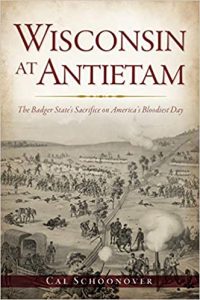Book Review: Wisconsin at Antietam: The Badger State’s Sacrifice on America’s Bloodiest Day
 Sometimes you just need everything in one place–background, analysis, good quotes, orders of battle, pertinent illustrations, some politics, maps, context, chapter notes, and an easy-to-use-index. From cover to cover, this little gem–Cal Schoonover’s Wisconsin at Antietam: The Badger State’s Sacrifice on America’s Bloodiest Day–does all of the above in less than 130 pages. If you have any interest in the Iron Brigade, Antietam, or are researching a paper or post, books like this one are invaluable. Author Schoonover, a Ph.D. candidate in American History, has given readers precisely the kind of book that can be read alongside the American Battlefield Trust maps of Antietam.
Sometimes you just need everything in one place–background, analysis, good quotes, orders of battle, pertinent illustrations, some politics, maps, context, chapter notes, and an easy-to-use-index. From cover to cover, this little gem–Cal Schoonover’s Wisconsin at Antietam: The Badger State’s Sacrifice on America’s Bloodiest Day–does all of the above in less than 130 pages. If you have any interest in the Iron Brigade, Antietam, or are researching a paper or post, books like this one are invaluable. Author Schoonover, a Ph.D. candidate in American History, has given readers precisely the kind of book that can be read alongside the American Battlefield Trust maps of Antietam.
One strength of Wisconsin at Antietam is the author’s ability to weave simple quotes into the manuscript. “A shell struck Gage in the head, killing him and three other soldiers instantly. ‘I could not see that he made a move,’ wrote Sergeant Alexander F. Lee of the 2nd Wisconsin.” The act of identifying both the writer and the deceased gives an immediacy to the event that books of this size usually do not include. These quotes are sprinkled generously throughout the volume. Another strength is the occasional inclusion of an opinioned comment. “The men of the Iron Brigade went into formation like the professional soldiers they were when called.” Schoonover’s respect for his subject is evident in his concise choice of words.
The order of chapters contributes to the ease of understanding both the battle and the book. Good organization contributes to the usefulness of Wisconsin at Antietam as source material. Initially, the reader learns how Wisconsin’s various regiments were formed within the state. The politics of leadership are briefly discussed, making it clear how officers were elected to their different positions. The second chapter explains how the armies on both sides moved their troops toward the inevitable. (This reviewer would like to personally thank the author for not taking pages out of his narrative to whine about McClellan and his “issues.” Just factual military information, thank you very much!) The battle at South Mountain is thoroughly covered in Chapter Three, “Clash at South Mountain.” This is one of the chapters when Schoonover uses longer quotations so effectively to flesh out his descriptions of the action at Crampton’s Gap. Combined with Hal Jesperson’s elegant maps, “Clash at South Mountain” is one of the best short explanations of what went wrong during the Maryland Campaign of 1862.
Immediate preparation for the battle of Antietam/Sharpsburg is covered in “On to Antietam Creek.” This chapter is another place where the author’s ability to put a great deal of information into a small space is appreciated. On page 64, he describes cavalry actions between the Union’s Colonel John E. Farnsworth and Confederate Fitzhugh Lee. Schoonover never belabors the military action. With the addition of sources, there is enough meat in this short paragraph from which to write a paper. The final chapter, “The Bloodiest Day,” gives readers a concise account of the battle on September 17, 1862. All the points made above occur here as well: quotes, maps, clearly delineated action.
An Afterword puts Antietam in its proper place as one of the significant battles of the American Civil War. This is followed by an Appendix containing the Order of Battle, notes, and an Index. Cal Schoonover has done a fine job presenting this battle in its entirety, shining a brighter light on the contributions of the Union’s Wisconsin soldiers while honoring Confederate efforts as well.
As a reviewer, I rarely suggest how to spend one’s money, but this small book belongs on many bookshelves. It is a guaranteed “go-to” for facts, figures, maps, and a pertinent quote. I am hopeful that The History Press expands its offerings to include more battle books like this one.
________________________________________
Cal Schoonover, Wisconsin at Antietam: The Badger State’s Sacrifice on America’s Bloodiest Day
The History Press, 2020
126 Pages
Appendix (Order of Battle), Notes, Index
